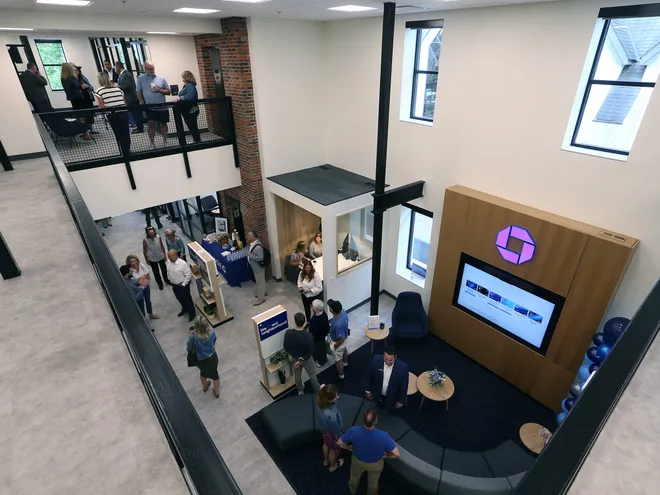Prefer to deposit checks in person? Bank branches may soon be hard to come by, report says
Stopping by the bank to make a quick deposit may soon become a relic of the past, according to a new study.
Finance and credit-building company Self Financial recently released a study using data provided by the Federal Deposit Insurance Corporation (FDIC) on consumer banking trends. Researchers obtained records dating as far back as 1934 and surveyed over 1,000 Americans to get the information compiled in the report, which shows one clear overall trend: in-person banking is currently on the outs.
According to the analyzed data, bank closures have been on the rise for more than a decade, with the number of physical branch locations consistently trending downward since 2012. Attributable to a variety of factors ranging from the 2008 financial crisis, the rise of online banking and the 2020 pandemic, this trend led researchers to theorize what the future may look like.
The study authors even projected the theoretical extinction of bank branches altogether, saying it could be possible were trajectories to remain exactly as they are now.
Widespread check fraud:The Chase ATM 'glitch' that went viral is likely check fraud, bank says
Capitalize on high interest rates: Best current CD rates
A long trend of branch closures
Since 2018, an average of 1,646 branches have closed each year in the U.S., according to the compiled data, bringing the total number of branches down to 69,590 in 2022 compared to 82,461 in 2012. As a result, consumers have fewer options for traditionally in-person services like mortgages.
To put things in perspective, that means there was one branch available per 4,715 people in 2022, the highest ratio of customers to branches since 1995. This trend is what prompted the report to speculate that physical branches could become extinct by 2041, were the numbers to continue along the same trajectory.
Some states also have fewer banks overall, regardless of recent increases and decreases. Hawaii, for example, has the fewest for its population, with only one bank branch per 9,797 people. Some Midwest states, on the other hand, including Iowa and Kansas, had less than 3,000 people vying for spots per branch.

States most affected by branch closures
Some states have higher incidences of branch closures than others, with California, Illinois and Florida leading the pack.
Between 2012 and 2022:
- California saw the highest level of bank closures with 1,080 branches shutting their doors.
- Florida came in second, with 1,056 closures.
- Illinois came in third, with 823 closures.
And while those numbers represent the states leading the closures, 45 states total reported branches consistently shuttering from 2002 to 2022.
A few states have managed to dodge the trend, including Nebraska, which saw an increase of 20 new branches, Vermont which welcomed 17, Montana with 16, South Dakota with 7 and North Dakota, which didn't add any branches but didn't lose any, either.
Using a polynomial regression model, type of number analysis that allows researchers to make predictions based on existing data, the study predicted that were current trends to remain steadfast, New England would see the most states go branchless the quickest. Connecticut, Maine and Vermont were predicted to be theoretically branchless by 2031.
Based on this model, Wyoming and Pennsylvania would be the only states to have in-person banking services into the 2080s. Of course, all this assumes a very specific circumstance and doesn't consider the many factors that would make this reality of being completely branchless unlikely.

Why are people forgoing in-person banking?
The most obvious answers to recent brick-and-mortar bank closures? The aftermath of the COVID-19 pandemic and the prevalence of online banking.
A 2023 survey of 1,046 Americans from across the U.S conducted as part of the study found that 69.9% of Americans believe banking systems need to change. It also found that 38.4%, or over one-third of Americans still visit a physical branch once a month, despite the overwhelming popularity of online options.
The study found that people are most likely to bank in person when performing certain activities. When asked what they go into branches for, respondents said:
- 63.2% visit bank branches to make cash deposits
- 56.5% visit a branch to speak to an advisor in person
- 53.6% visit to make a cash withdrawal.
These numbers reflected a 29.4% decrease in people using physical bank branches primarily for cash, something the researchers attributed to a move toward a cashless society partially as a result of the pandemic and businesses moving to card-only payments.
Some people make decisions to use online versus in-person banking based on perceptions of trust. The study found that:
- 39% said they trusted physical bank branches more
- A similar 36.1% said they had the most trust in online or website banking
- 24.9% said app-based banking felt the safest.
Those who preferred in-person banking cited better security and access to advisors, easier (and free) access to cash and an easier deposit and withdrawal system. Concerns about online banking echoed these themes, with respondents saying they had concerns about security, lack of free ATM access, lack of access to real people to speak with and confusion or complications related to the mechanics of banking online.
Even so, 73.2% of those surveyed said they believe online banking will outnumber traditional banks within the next twenty years.
Disclaimer: The copyright of this article belongs to the original author. Reposting this article is solely for the purpose of information dissemination and does not constitute any investment advice. If there is any infringement, please contact us immediately. We will make corrections or deletions as necessary. Thank you.







